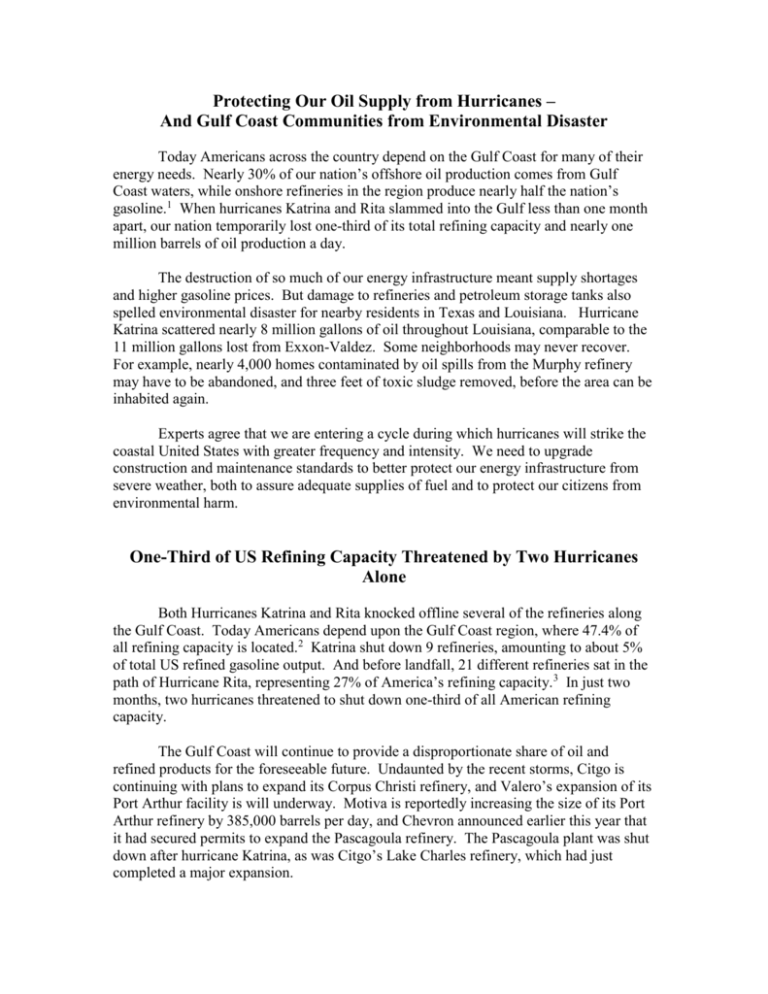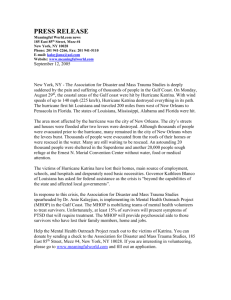Protecting Our Oil Supply from Hurricanes
advertisement

Protecting Our Oil Supply from Hurricanes – And Gulf Coast Communities from Environmental Disaster Today Americans across the country depend on the Gulf Coast for many of their energy needs. Nearly 30% of our nation’s offshore oil production comes from Gulf Coast waters, while onshore refineries in the region produce nearly half the nation’s gasoline.1 When hurricanes Katrina and Rita slammed into the Gulf less than one month apart, our nation temporarily lost one-third of its total refining capacity and nearly one million barrels of oil production a day. The destruction of so much of our energy infrastructure meant supply shortages and higher gasoline prices. But damage to refineries and petroleum storage tanks also spelled environmental disaster for nearby residents in Texas and Louisiana. Hurricane Katrina scattered nearly 8 million gallons of oil throughout Louisiana, comparable to the 11 million gallons lost from Exxon-Valdez. Some neighborhoods may never recover. For example, nearly 4,000 homes contaminated by oil spills from the Murphy refinery may have to be abandoned, and three feet of toxic sludge removed, before the area can be inhabited again. Experts agree that we are entering a cycle during which hurricanes will strike the coastal United States with greater frequency and intensity. We need to upgrade construction and maintenance standards to better protect our energy infrastructure from severe weather, both to assure adequate supplies of fuel and to protect our citizens from environmental harm. One-Third of US Refining Capacity Threatened by Two Hurricanes Alone Both Hurricanes Katrina and Rita knocked offline several of the refineries along the Gulf Coast. Today Americans depend upon the Gulf Coast region, where 47.4% of all refining capacity is located.2 Katrina shut down 9 refineries, amounting to about 5% of total US refined gasoline output. And before landfall, 21 different refineries sat in the path of Hurricane Rita, representing 27% of America’s refining capacity.3 In just two months, two hurricanes threatened to shut down one-third of all American refining capacity. The Gulf Coast will continue to provide a disproportionate share of oil and refined products for the foreseeable future. Undaunted by the recent storms, Citgo is continuing with plans to expand its Corpus Christi refinery, and Valero’s expansion of its Port Arthur facility is will underway. Motiva is reportedly increasing the size of its Port Arthur refinery by 385,000 barrels per day, and Chevron announced earlier this year that it had secured permits to expand the Pascagoula refinery. The Pascagoula plant was shut down after hurricane Katrina, as was Citgo’s Lake Charles refinery, which had just completed a major expansion. Oil Rigs in Gulf are Currently No Match for Hurricane Force Winds Hurricanes may shut down oil refineries, but they are even more hazardous to offshore oil rigs. Following Hurricane Rita, the Federal Minerals Management Service reported that nearly 99% of oil production in the Gulf had been shut down due to the storm, or about 1.5 million daily barrels.4 Because the entire nation depends on oil production in the Gulf, each hurricane that approaches the Gulf Coast now threatens a fundamental part of the American economy. On October 24th, the Federal Minerals Management Service reported that Hurricane Wilma had already shut down the offshore drilling production of more than 1.5 million barrels per day, which is roughly equivalent to 67.9% of all Gulf Coast oil production.5 Yet Hurricanes Katrina and Rita did even more damage to mobile drilling units located in the Gulf. Following Rita fourteen mobile drilling units either sank or were destroyed, and 12% of drilling rigs in Katrina’s path were either destroyed or damaged severely. Some rigs actually slammed into other rigs causing significant damage, and four rigs operated by Noble Corporation drifted 75 to 123 miles off their original locations.6 Often times when these mobile oil drilling units (MOBUs) move during a hurricane, they drag themselves along the floor of the ocean, breaking, moving, or otherwise impeding oil and gas pipelines. Some companies have chosen to build their oil rigs in the Gulf today to withstand a Category 1 or a Category 2 hurricane (winds less than 115mph).7 Yet no company is required to build an oil rig—be it stationary or mobile—that can withstand the winds of a Category 3 or stronger hurricane. Federal Agencies Disagree over Authority and Responsibility This kind of widespread damage could be prevented if MOBUs—as well as stationary oil rigs—were built with specific safety standards. Of the 4,000 platforms that the Federal Minerals Management Service administers in the Gulf, 3,050 platforms were in the path of Hurricanes Katrina and Rita. However, when asked about standards concerning the anchoring of mobile rigs during hurricanes, the Federal Minerals Management Service insisted that they hold no authority, and that instead the responsibility is entirely within the jurisdiction of the Coast Guard. Jolie Schifflet with the Coast Guard responded: "I know MMS told you that it is our responsibility, and I can see why they may have said that. The responsibility in general for offshore is shared by MMS and the Coast Guard; however, the specific element you asked about, the forces these rigs must stand up to, that is set by MMS."8 Currently no governmental agency claims the authority, or the responsibility, to ensure that our nation’s oil rigs are actually built to withstand the winds of a category 3 hurricane. Gulf Coast Communities Soaked in Millions of Gallons of Oil In the aftermath of Hurricane Katrina, the Coast Guard has estimated that nearly 8 million gallons of oil spilled from industrial plants, storage depots and other facilities around southeast Louisiana.9 One of the largest spills was at the Murphy Oil Refinery in Meraux, LA, where over 800,000 gallons of oil poured into neighboring homes and streets.10 It is now estimated that in Meraux alone, over 4,000 homes will have to be razed, and the three feet of sludge removed, before the area can ever be inhabited again. Overall, the Coast Guard reported numerous spills following Hurricane Katrina11: Name of Company Bass Enterprises Production Company Shell Chevron Murphy Oil Bass Enterprises Chevron Venice Energy Services Company Shell Pipeline Oil Sundown Energy Location of spill Cox Bay Gallons spilt Pilot Town Empire Meraux Point a la Hache Port Fourchon Venice 1.05 million 991,000 819,000 461,000 53,000 25,000 847,000 gallons 7,600 gallons 501,000 gallons About 230,000 gallons 26,420 gallons 4,800 gallons Nairn 13,440 3066 gallons West Potash 13,000 2,153 gallons 3.78 million Amount Recovered/contained 2,960,000 gallons Many of these spills now threaten wildlife in surrounding wetland areas as well as the lives of individuals who now live in the communities that have been contaminated with oil. The oil that now covers the streets in Meraux serves as a powerful reminder of our nation’s obligation to restore these facilities with the proper protections to ensure that the next time a hurricane passes through the area, local citizens will not return home to find their neighborhood drenched in toxic oil. Now the Environmental Protection Agency is finding extraordinarily high levels of Diesel Range Organics—leftover from all of the oil spills in the area—in sediment samples in and throughout New Orleans. Because the Louisiana Department of Environmental Quality has set their safe soil standard for Diesel Range Organics at 61,000 µ/kg, the recent findings of the EPA are quite alarming. Levels of Diesel Range Organics in Soil Samples in New Orleans Neighborhoods. EPA Station and Date Collected 8935 (09/12) 9362 (09/15) 9684 (09/25) 9816 (09/25) 9895 (09/25) 9897 (09/26) 9899 (09/26) 9950 (09/27) 9951 (09/27) 9976 (09/05) 9978 (09/27) 9985 (09/27) 9987 (09/27) 10173 (09/30) Parish Level Detected µ/kg St. Bernard Orleans Orleans Orleans Orleans Orleans Orleans Orleans Orleans Orleans Orleans Orleans Orleans St. Bernard 9,920,000 2,010,000 9,140,000 1,280,000 1,140,000 1,180,000 8,250,000 1,430,000 3,160,000 6,850,000 1,310,000 2,490,000 2,200,000 1,230,000 Percent Above LDEQ Standard 16,300% 3,300% 15,000% 2,100% 1,900% 1,900% 13,500% 2,300% 5,200% 11,200% 2,100% 4,100% 3,600% 2,100% Gulf Coast Facing More and Stronger Hurricanes than ever before In just the last year, five major (major denotes Category 3 winds or higher) Gulf Coast hurricanes have threatened and/or damaged the Gulf’s oil rigs (Ivan, Dennis, Katrina, Rita, and Wilma—see chart below). Experts now agree that we are entering a cycle in which hurricanes will have great intensity and occur with greater frequency, increasing the likelihood that the Gulf Coast will face many more major hurricanes in the next few years.12 The National Weather Center’s Climate Prediction Center has announced that this increase in intensity, due to natural hurricane cycles, could last as long as a decade, if not longer. If Global Warming is truly a reality, not only will hurricanes occur with more frequency, but they will occur with greater intensity due to the warmer temperature in the Gulf.13 Major Hurricanes that Struck the Gulf Coast in the last 25 years.14 Name Category Landfall Date Hurricane Alicia 3 08/19/1983 Hurricane Andrew 4 Hurricane Opal 4 Western end of Galveston Island, TX Florida, as well as the central LA coast Pensacola Beach, FL Hurricane Charley 4 Captiva Island, FL 08/14/2004 Hurricane Ivan 4 Gulf Shores, AL 09/16/2004 Hurricane Dennis 3 Santa Rosa Island, FL 07/12/2005 Hurricane Katrina 4 Southeast LA 08/29/2005 Hurricane Rita 4 LA and TX border 09/24/2005 Hurricane Wilma 3 Cape Romano, FL 10/24/2005 08/23/1992 and then again on 08/26/1992 10/04/1995 There are many lessons to be learned in the aftermath of Hurricanes Katrina and Rita. With an increasing number of stronger hurricanes threatening to strike the Gulf Coast in the upcoming years, we cannot simply restore the Gulf Coast to its previous state. Citizens who live near refineries deserve the proper protections to protect their lives and property from the contamination of spilt oil. Because our entire nation depends upon the energy that oil production in the Gulf provides, the insecurity of our oil rigs in the Gulf is a matter of national security. Instead of trying to roll back environmental rules in the mistaken belief that such action will somehow increase the supply and lower the price of gasoline, Congress should take action to require federal agencies to strengthen construction and maintenance standards for refineries, pipelines and offshore rigs, so that they are better able to withstand severe weather. Legislation should charge the appropriate federal agencies with the responsibility for writing regulations that would: 1) protect the nation’s energy infrastructure from hurricanes and severe weather events, 2) minimize the loss of productive capacity, and 3) minimize the release of oil and other pollutants during and after hurricane events. We already know that hurricanes will strike the Gulf again, perhaps with even more force than we have seen before. If we want to avoid spiraling gas prices and oil spills that wipe out entire communities, we ought to take reasonable precautions to minimize damage from tomorrow’s storms. 1 2 See EIA website: (http://tonto.eia.doe.gov/oog/special/eia1_katrina.html) See EIA website: (http://tonto.eia.doe.gov/oog/special/eia1_katrina.html ) 3 See Southwend’s website: (http://www.southend.wayne.edu/modules/news/article.php?storyid=1630) 4 See CNN website: (http://money.cnn.com/2005/09/30/news/economy/hurricane_repairs/) See Federal Mineral Management Service’s website: (http://www.mms.gov/ooc/press/2005/press1024.htm ) 6 See Mobile Register’s website: (http://www.al.com/news/mobileregister/index.ssf?/base/news/112789905291350.xml&coll=3&thispage=1 ) 7 See Mobile Register’s website: (http://www.al.com/news/mobileregister/index.ssf?/base/news/112789905291350.xml&coll=3&thispage=1 ) 8 See Mobile Register’s website: (http://www.al.com/news/mobileregister/index.ssf?/base/news/112789905291350.xml&coll=3&thispage=1 ) 9 See MSNBC website: (http://www.msnbc.msn.com/id/9365607/) 10 See Pittsburgh Post Gazette website: (http://www.post-gazette.com/pg/05255/570138.stm) 11 See MSNBC website: (http://www.msnbc.msn.com/id/9365607/) 12 See Live Science website: (http://www.livescience.com/forcesofnature/050831_hurricane_freq.html) 13 See National Weather Center website: (http://www.cpc.ncep.noaa.gov/products/outlooks/hurricane.html) 14 See National Hurricane Center website: (http://www.nhc.noaa.gov/) 5







